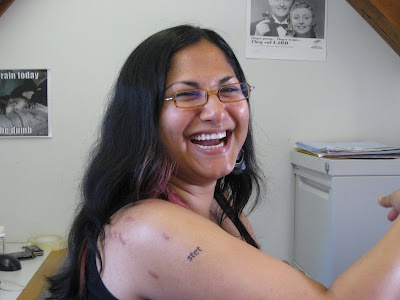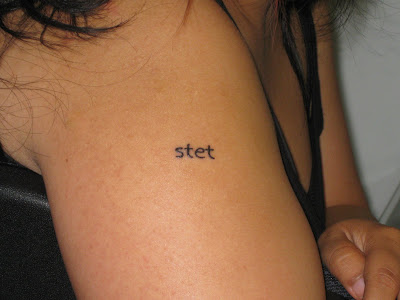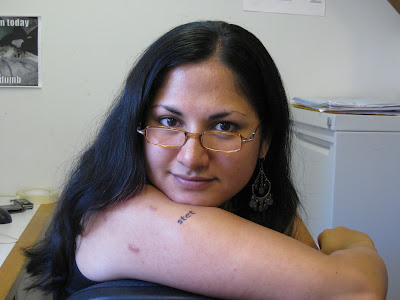Nadia’s been wanting to get a tattoo for…well, forever. Certainly she wanted to get one soon after we got to Australia (back in the middle of 2006) but there was a problem: she couldn’t decide what she wanted the tattoo to be, say, or represent.
Last week, however, she had a eureka moment and three days later, it was done:

Yes, the tattoo says ‘stet’.
Er, ‘Stet’?
So, what does ‘stet’ mean? Well, ‘stet’ is an editing/proofreading mark that means “Let it stand” or “You know that change you made? Undo it and leave my original text the way it was, thank you very much”. Author Max Barry explains it best:
On Monday I received the copyedited manuscript of Company. This means someone at Doubleday has gone through it with a red pencil and pointed out everything I did wrong …
…[If] I want, I can overrule them, with the awesome power of STET. “Stet,” I discovered while editing my first novel, means, “Put everything back just the way I had it.” (Accompanied, one suspects, by the subtext: “Idiot!”) How good is that? When I discovered this word, it was like a gnawing, hollow place in my heart had finally been filled. Looking back, I can’t work out how I ever made it through a day without it. “Max, I tidied up your desk for you.” “No! Stet! STET, dammit!”
This is the coolest and most powerful mark (read: command) that an author has over her editor and proof reader and I presume this is what JRR Tolkien used when he started spelling the plural of ‘dwarf’ as ‘dwarves’ – instead of the more commonly used ‘drwarfs’ – when he wrote his ‘Lord of the Rings’ trilogy [More on this here].
Anyway, here’s a close-up of the tattoo:

Isn’t it awesome? It’s simple, yet powerful and relevant on so many levels.
The inspiration for this tattoo came from two places, by the way: the Science Tattoo Emporium (that Carl Zimmer maintains on his Discover Magazine blog) and our love of geeky t-shirts (the kind you find on Think Geek). And though I am honoured to be the one who suggested ‘stet’ to her, I’m pretty sure she would have gotten to it on her own anyway.
The Middle of the Story
What was funny, however, was the way in which it finally happened. Nadia had decided to get her tattoo from Tattoo Magic in Fitzroy so, on the morning of 27 January, the two of us made our way down to Tattoo Magic to have a consultation with one of their artist and to book in a date and time for when the actually tattooing would take place (which would hopefully be some time later that week).
When we got there, however, their receptionist was out to lunch so we ended up talking to a couple of tattoo artists directly. When they saw what Nadia wanted for her tattoo, one of them said tattooing this would take just a couple of minutes and he could do it right then. After a slight hesitation, Nadia said ‘yes’ so the artist (Sean Jackson) went to his office to make a stencil that he would use to size and place the tattoo on Nadia’s arm.
Making the stencil took about five minutes, placing it correctly on Nadia’s arm took less than a minute, and the actual tattooing took less than three minutes (and it wasn’t painful). So, after having waited for two and half years to get a tattoo, Nadia walked out of a tattoo parlour with the tattoo she really wanted less than twenty minutes after she had walked in!
Also funny was that Nadia had psyched herself up for a painful tattooing experience and I was there holding her hand when Sean started to make the first line. I didn’t laugh out loud but I did chuckle inwardly as her facial expression went from “Must tolerate this pain…must tolerate this pain…” to “Er, WTF? This barely stings” :)
So there you have it, Nadia has a tattoo:

You can see more photos (including some funny ones) on my ‘Nadia and her Tattoo’ Picasa Web Albums gallery.




